|
 The Mound Builders:
(Altered Landscapes).
The Mound Builders:
(Altered Landscapes).
USA has more
than 100,000 artificial mounds between the great lakes and the Gulf
of Mexico. (12)
The varying cultures
collectively called Mound Builders were prehistoric
inhabitants of North America who, during a 5,000-year period,
constructed various styles of earthen mounds for religious and
ceremonial, burial, and elite residential purposes. These
included the Pre-Columbian cultures of the Archaic period;
Woodland period; and Mississippian period; dating from roughly
3,400 BC to the 16th century AD, and living in regions of the
Great Lakes, the Ohio River valley, and the Mississippi River
valley and its tributaries. (15)
Watson Brake: The Oldest Mound Complex in North
America:
Watson
Brake is the oldest archaeological site in Louisiana
dating from the Archaic period. It is also one of the the
earliest complex construction in the Americas. The complex is
made of an arrangement of human-made mounds located in the
floodplain of the Ouachita River near Monroe in northern
Louisiana, United States. Watson Brake consists of an oval
formation of eleven mounds from three to 25 feet (7.6 m) in
height, connected by ridges to form an oval nearly 900 feet (270
m) across. The analysis of 27 radiocarbon dates indicates that
the site was initially occupied around 4,000 BC during the
Middle Archaic period. Mound construction began at approximately
3,500 BC, and continued for approximately 500 years.
(6)
The first
recognised mound-building culture in the North America's is the
Adena culture, which existed from around 1,000 BC - 200 BC, in
a time also known as the 'Early Woodland Period'.
(1)
Grave-Creek
mound:

Grave Creek Mound, Moundsville, (c. 200 BC). The
largest
of several funerary mounds in the area.
Grave Creek Mound is probably the most famous
of the Adena burial mounds, and certainly one of the most
impressive (over 600,000 tons of earth). Not only is it the
largest Adena mound, but it is the largest conical type of any
of the mound builder structures. In 1838, road engineers
measured the height of the mound at 69 feet and the diameter at
the base as 295 feet. Originally a moat of about 40 feet in
width and five feet in depth with one causeway encircled the
mound. Construction of the mound took place in successive stages
from about 250-150 B.C., as indicated by the multiple burials at
different levels within the structure. The building of the mound
and moat must have been a massive undertaking, since the total
effort required the movement of over 60,000 tons of earth.
The Inscribed Stone from Grave-Creek Mound:
When the mound was opened in 1838, by Mr Tomlinson, the owner of
the land, he found skeletons, adorned with plates of mica,
copper rings and ivory beads, along with 'The Inscribed Stone'.
Although this stone has caused much debate since its discovery,
it seems that there is little debate over its existence (As it
is held by the Smithsonian Institute). It is still today classified
officially as an 'anomalous artefact'. A replica is on display
in the local museum.
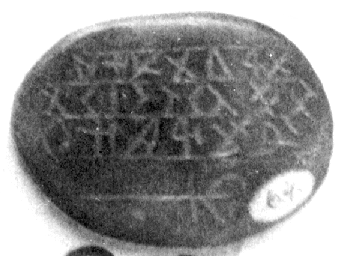 |
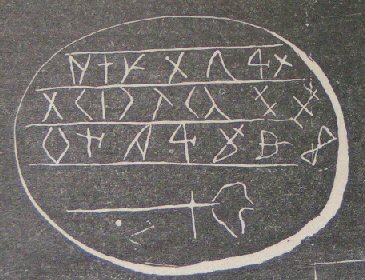 |
|
The
Grave Creek Stone
Smithsonian
photograph 90-9022
(MS 3146, E.H. Davis Collection,
National Anthropological Archives)
|
The
Grave Creek Stone
Buffalo and Erie County Historical Library
(Image Drawn By P.P. Cherry, Wadsworth Ohio,
1877)
|
There have been numerous discoveries of
inscribed Adena tablets since the Grave-Creek mound discovery,
supporting the supposition that the Grave-Creek Tablets might be
authentic (although there is no reference to any with script).
This from Wiki: 'The Adena carved small stone tablets, usually 4
or 5 inches by 3 or 4 inches by .5 inches thick. On one or both
flat sides were gracefully composed stylized zoo-morphs or
curvilinear geometric designs in deep relief. Paint has been
found on some Adena tablets, leading archaeologists to propose
that these stone tablets were probably used to stamp designs on
cloth or animal hides, or onto their own bodies. Its possible
they were used to outline designs for tattooing.
(1)
Article: (P.P. Cherry, 1877) -
'The
Grave-Creek Inscribed Stone, with its
Vindication'. (Quick-link)
|
The Ohio Serpent Mound.
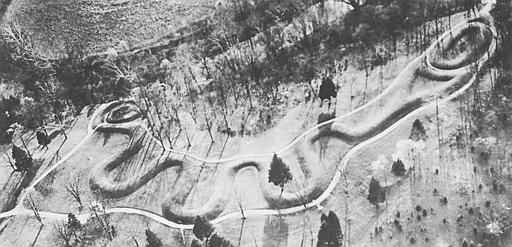
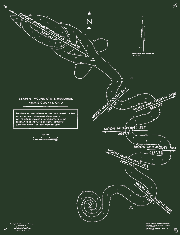 Long
believed to be a part of the Adena Culture based on the presence
of Adena burials nearby. This serpent effigy (the largest in the
world) is now attributed to the later 'Fort Ancient' culture.
(3).
It has
been proposed (2) (3),
that the serpent mound was an astronomically based, symbolic
landscape feature: Long
believed to be a part of the Adena Culture based on the presence
of Adena burials nearby. This serpent effigy (the largest in the
world) is now attributed to the later 'Fort Ancient' culture.
(3).
It has
been proposed (2) (3),
that the serpent mound was an astronomically based, symbolic
landscape feature:
'Lunar alignments correspond
to six of the seven coils of the serpent effigy. The coils to
the right point to the moon's maximum northern, southern, and
central rising points, and the coils to the left point to the
moons maximum northern, southern and central setting points. As
such, the serpent is closely identified with the moon, and with
the underworld. The head and oval also point to the sun's
maximum northern setting point, during the summer solstice, and
appear to show the sun symbolically being "swallowed" by the
serpent. The serpent is also aligned to true north via a line
travelling from the centre of its coiled tail to the base of its
head'. (2)
(More
about Archaeoastronomy)
Adena Shamanism:
Although the mounds are beautiful artistic achievements
themselves, Adena artists created smaller, more personal
pieces of art. Art motifs that became important to many
later Native Americans began with the Adena. Motifs such
as the weeping eye and cross and circle design became
mainstays in many succeeding cultures. Many pieces of
art seemed to revolve around shamanic practices, and the
transformation of humans into animals�particularly
birds, wolves, bears and deer�and back to human form.
This may indicate a belief that the practice imparted
the animals' qualities to the wearer or holder of the
objects. Deer antlers, both real and constructed of
copper, wolf, deer and mountain lion jawbones, and many
other objects were fashioned into costumes, necklaces
and other forms of regalia by the Adena. Distinctive
tubular smoking pipes, with either flattened or
blocked-end mouthpieces, suggest the offering of smoke
to the spirits. The objective of pipe smoking may have
been altered states of consciousness, achieved through
the use of the hallucinogenic plant Nicotiana rustica.
All told, Adena was a manifestation of a broad regional
increase in the number and kind of artefacts devoted to
spiritual needs.
(More
about Shamanism)
By about 200
B.C., the Adena culture had given way to the more sophisticated
Hopewell tradition.
The 'Hopewell tradition' is the
name used to describe the common
aspects of the
Native American culture that flourished along rivers in the
north-eastern and mid-western
United States from 200
BC to 500
AD. The Hopewell tradition was not a single culture or society, but a widely dispersed set of related
populations. They were connected by a common network of trade
routes,
known as the Hopewell Exchange System.
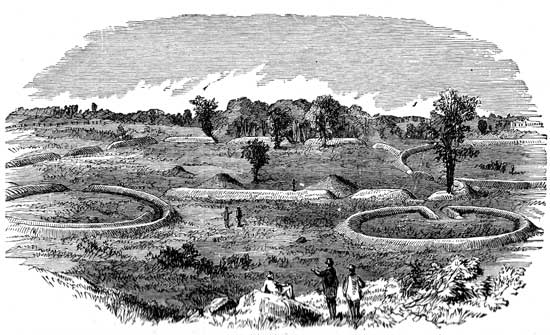
The great geometric
earthworks are amongst the most impressive
monuments throughout American prehistory.
 The
Great Octagon: A Lunar Observatory - Several
scientists, including Dr. Bradley T. Lepper, Curator of
Archaeology,
Ohio Historical Society, hypothesize that the
Octagon earthwork at
Newark, Ohio, was a
lunar
observatory oriented to the 18.6 year cycle of
minimum and maximum lunar risings and settings on the
local horizon. Dr. John Eddy completed an unpublished
survey in 1978, and proposed a lunar major alignment for
the Octagon. Ray Hively and Robert Horn of
Earlham College in
Richmond, Indiana were the first researchers to
analyze numerous lunar sightlines at the
Newark Earthworks (1982) and the
High Banks Works (1984) in
Chillicothe, Ohio,
Christopher Turner noted that the Fairground Circle
in Newark, Ohio aligns to the sunrise on May 4, i.e.
that it marked the May cross-quarter sunrise.
In 1983,
Christopher Turner demonstrated that the Hopeton
Earthworks encode various sunrise and moonrise patterns,
including the winter and summer
solstices, the
equinoxes, the
cross-quarter days, the
lunar maximum events, and the
lunar minimum events. (5) The
Great Octagon: A Lunar Observatory - Several
scientists, including Dr. Bradley T. Lepper, Curator of
Archaeology,
Ohio Historical Society, hypothesize that the
Octagon earthwork at
Newark, Ohio, was a
lunar
observatory oriented to the 18.6 year cycle of
minimum and maximum lunar risings and settings on the
local horizon. Dr. John Eddy completed an unpublished
survey in 1978, and proposed a lunar major alignment for
the Octagon. Ray Hively and Robert Horn of
Earlham College in
Richmond, Indiana were the first researchers to
analyze numerous lunar sightlines at the
Newark Earthworks (1982) and the
High Banks Works (1984) in
Chillicothe, Ohio,
Christopher Turner noted that the Fairground Circle
in Newark, Ohio aligns to the sunrise on May 4, i.e.
that it marked the May cross-quarter sunrise.
In 1983,
Christopher Turner demonstrated that the Hopeton
Earthworks encode various sunrise and moonrise patterns,
including the winter and summer
solstices, the
equinoxes, the
cross-quarter days, the
lunar maximum events, and the
lunar minimum events. (5)
(Other
Images of Hopewell Geometric Earthworks)
(Archaeoastronomy)
Platform (Effigy) Pipes:
The Hopewell tradition is also known for the
discovery of several large caches of effigy (or platform) pipes.
Most famously, the 136 from Tremper mound, and the cache of nearly
250 animal and human effigy pipes from Mound 8 at Mound City north
of Chillicothe They are found broken, or 'killed', in large
crematory basins. (4)

|






 The
Great Octagon: A Lunar Observatory - Several
scientists, including Dr. Bradley T. Lepper, Curator of
Archaeology,
Ohio Historical Society, hypothesize that the
Octagon earthwork at
Newark, Ohio, was a
lunar
observatory oriented to the 18.6 year cycle of
minimum and maximum lunar risings and settings on the
local horizon. Dr. John Eddy completed an unpublished
survey in 1978, and proposed a lunar major alignment for
the Octagon. Ray Hively and Robert Horn of
Earlham College in
Richmond, Indiana were the first researchers to
analyze numerous lunar sightlines at the
Newark Earthworks (1982) and the
High Banks Works (1984) in
Chillicothe, Ohio,
Christopher Turner noted that the Fairground Circle
in Newark, Ohio aligns to the sunrise on May 4, i.e.
that it marked the May cross-quarter sunrise.
In 1983,
Christopher Turner demonstrated that the Hopeton
Earthworks encode various sunrise and moonrise patterns,
including the winter and summer
solstices, the
equinoxes, the
cross-quarter days, the
lunar maximum events, and the
lunar minimum events. (5)
The
Great Octagon: A Lunar Observatory - Several
scientists, including Dr. Bradley T. Lepper, Curator of
Archaeology,
Ohio Historical Society, hypothesize that the
Octagon earthwork at
Newark, Ohio, was a
lunar
observatory oriented to the 18.6 year cycle of
minimum and maximum lunar risings and settings on the
local horizon. Dr. John Eddy completed an unpublished
survey in 1978, and proposed a lunar major alignment for
the Octagon. Ray Hively and Robert Horn of
Earlham College in
Richmond, Indiana were the first researchers to
analyze numerous lunar sightlines at the
Newark Earthworks (1982) and the
High Banks Works (1984) in
Chillicothe, Ohio,
Christopher Turner noted that the Fairground Circle
in Newark, Ohio aligns to the sunrise on May 4, i.e.
that it marked the May cross-quarter sunrise.
In 1983,
Christopher Turner demonstrated that the Hopeton
Earthworks encode various sunrise and moonrise patterns,
including the winter and summer
solstices, the
equinoxes, the
cross-quarter days, the
lunar maximum events, and the
lunar minimum events. (5)